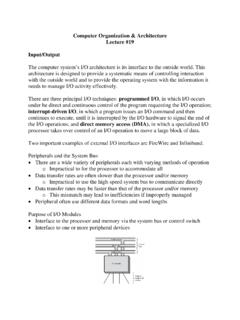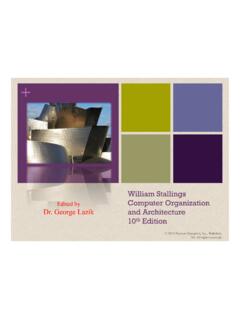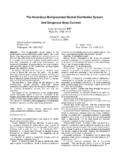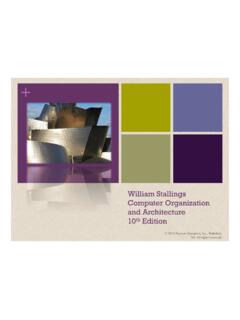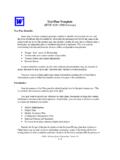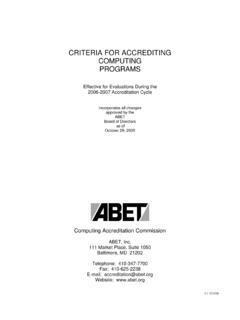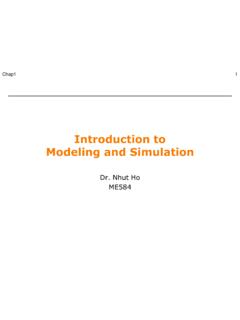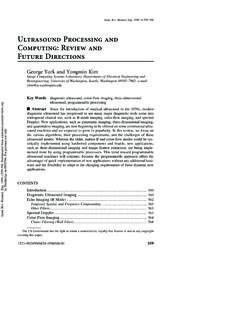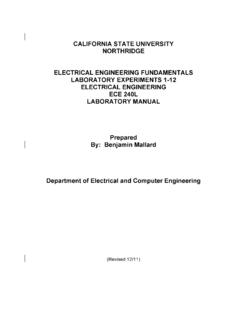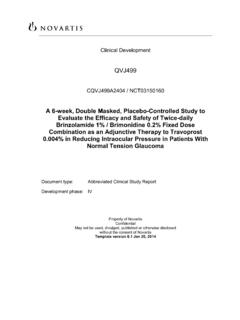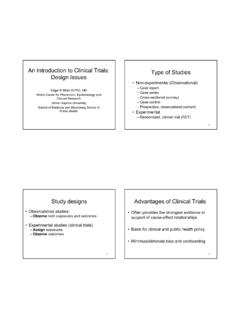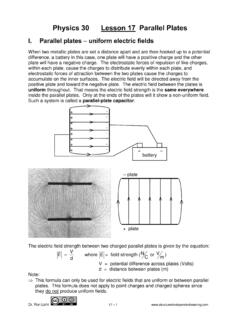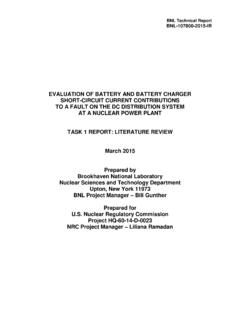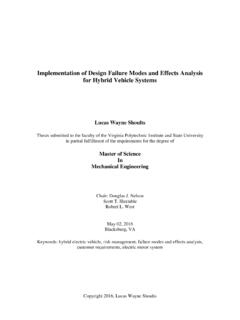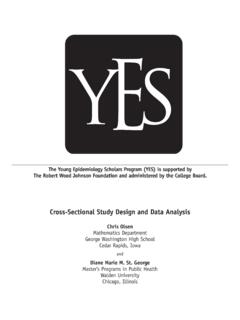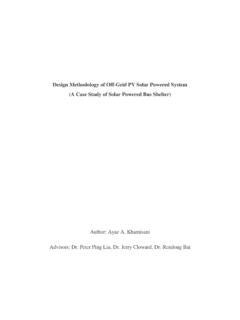Transcription of Modeling Mechanical Systems - California State University ...
1 Modeling Mechanical SystemsDr. Nhut HoME584chp31 Agenda Idealized Modeling Elements Modeling Method and Examples Lagrange s Equation Case study: Feasibility Study of a Mobile Robot Design Matlab Simulation example Active learning: Pair-share exercises, case studychp32 Idealized Modeling Elementschp33 Inductive storageElectrical inductanceTranslational springRotational springFluid inertiachp34 Capacitive StorageElectrical capacitanceTranslational massRotational masschp35 Energy dissipatorsElectrical resistanceTranslational damperRotational damperchp36 Springs-Stiffness Element-Stores potential energychp3x7 Actual Spring Behaviorchp38 Spring Connections Spring in series.
2 KEQ=K1K2/(K1+K2) Spring in parallel: KEQ=K1+K2chp39 Dampers and Masschp310 Dampers Connections Dampers in series: BEQ=B1B2/(B1+B2) Dampers in parallel: BEQ=B1+B2chp311 Modeling Mechanical Systemschp312 Modeling Methods State assumptions and their rationales Establish inertial coordinate system Identify and isolate discrete system elements (springs, dampers, masses) Determine the minimum number of variables needed to uniquely define the configuration of system (subtract constraints from number of equations) Free body diagram for each element Write equations relating loading to deformation in system elements Apply Newton s 2ndLaw: F = ma for translation motion T = I for rotational motionchp313 example 1: Automobile Shock AbsorberSpring-mass-damperFree-body diagram)()()()(22trtkydttdybdttydM chp314 example 2: Mechanical System Draw a free body diagram, showing all forces and their directions Write equation of motion and derive transfer function of response x to input uchp315 example 2: Mechanical Systemchp316 example 3: Two-Mass System Derive the equation of motion for x2as a function of Fa.
3 The indicated damping is viscous. chp317 example 3: Two-Mass Systemchp318 example 4: Three-Mass System Draw the free-body-diagram for each mass and write the differential equations describing the systemchp319 example 4: Three-Mass Systemchp320 example 5: Pair-Share Exercise All springs are identical with constant K Spring forces are zero when x1=x2=x3=0 Draw FBDs and write equations of motion Determine the constant elongation of each spring caused by gravitational forces when the masses are stationary in a position of static equilibrium and when fa(t) = 5: Pair-Share Exercise: chp322 example 5: Pair-Share Exercise: chp323 example 6: Pair-Share Exercise Assume that the pulley is ideal No mass and no friction No slippage between cable and surface of cylinder ( , both move with same velocity) Cable is in tension but does not stretch Draw FBDs and write equations of motion If pulley is not ideal, discuss Modeling modificationschp324 example 6: Pair-Share Exercisechp3 Pulley is not ideal Add rotationmass and friction Model the slippagebehaviors Add spring to model cable 25 example 7: Electric Motor An electric motor is attached to a load inertia through a flexible shaft as shown.
4 Develop a model and associated differential equations (in classical and State space forms) describing the motion of the two disks J1 and J2. Torsional stiffness is given in Appendix Bchp326 example 7: Electric Motorchp327 example 7: Electric Motorchp328 example 7: Electric Motorchp329 example 8: Pair-Share Exercise: Copy Machine chp3 The device from a copying machine is shown. It moves in a horizontal plane. Develop the dynamic model, assuming that mass of bar is negligible compared to attached mass m2and angular motions are small. The mass is subjected to a step input F, find an expression for the displacement of point B after the transient motions have died out.
5 30 example 8: Pair-Share Exercise: Copy Machine chp331 example 9: Mass-Pulley System A Mechanical system with a rotating wheel of mass mw(uniform mass distribution). Springs and dampers are connected to wheel using a flexible cable without skip on wheel. Write all the Modeling equations for translational and rotational motion, and derive the translational motion of x as a function of input motion u Find expression for natural frequency and damping ratiochp332 example 9: Mass-Pulley Systemchp333 example 9: Mass-Pulley Systemchp334 example 9: Mass-Pulley Systemchp335 example 10: Pair-Share Exercise: Double Pendulum The disk shown in the figure rolls without slipping on a horizontal plane.
6 Attached to the disk through a frictionless hinge is a massless pendulum of length L that carries another disk. The disk at the bottom of the pendulum cannot rotation relative to the pendulum arm. Draw free-body diagrams and derive equations of motion for this 10: Pair-Share Exercise: Double Pendulumchp337 example 10: Pair-Share Exercise: Double Pendulumchp338 example 10: Pair-Share Exercise: Double Pendulumchp339
